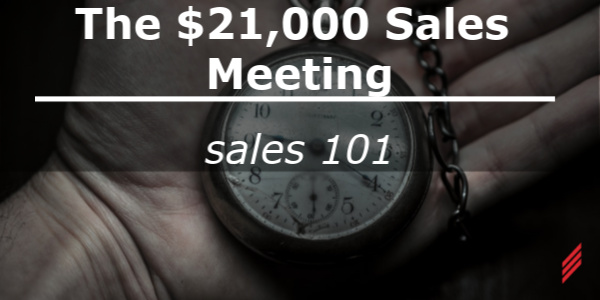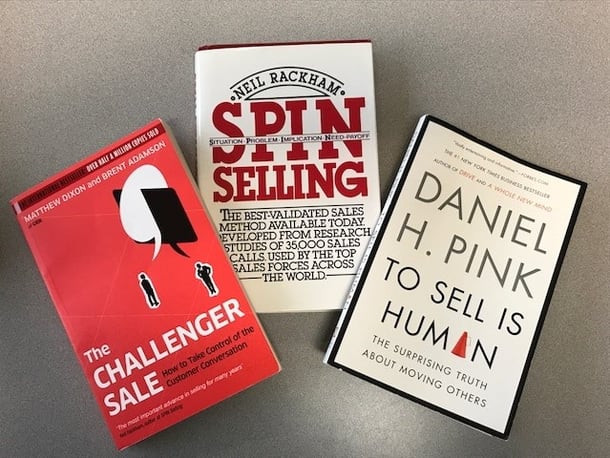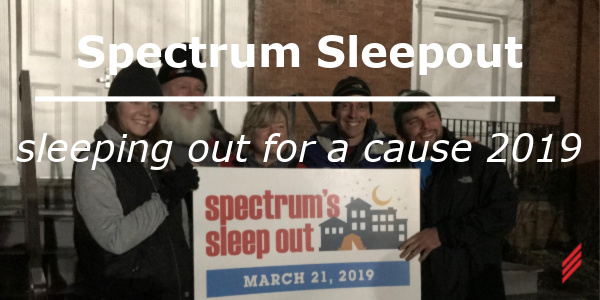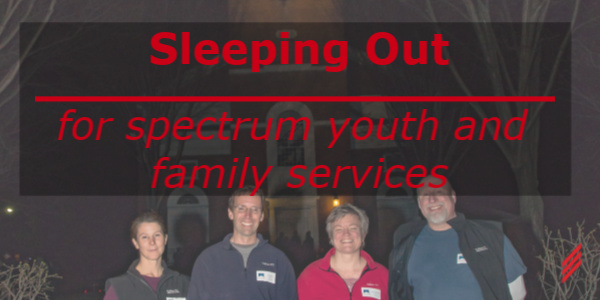The $21,000 Meeting-Sales 101
by Keith Flaherty on Apr 28, 2022 10:25:00 AM

As the temperature dropped to 25°F on the evening of March 23rd in Burlington, Vermont, I burrowed into my sleeping bag to keep warm. I was with five colleagues from Hallam-ICS and more than 100 other members of the local business community sleeping outside for a night to raise money for Spectrum Youth and Family Services. This was the second year we took part in this event. How we became participants and strong supporters of Spectrum can be traced back to a single meeting that started with a simple email that represents, for me, one of the basic concepts of sales. Time and Timing.
Before I delve into what I mean by Time and Timing, let me put my personal sales experience in context. I have little formal sales training. I am an engineer who either learned how to sell or risked the survival of a company I loved being a part of.
I started at Hallam-ICS in 1989, one week after graduating from the University of Vermont with a degree in electrical engineering, and have been here ever since. I had met Dave Hallam, the company founder, earlier that year. Dave was a visionary leader who emphasized that our culture and commitment to social responsibility was as important as the engineering and automation services we provided to our clients (click here to read more about Why Dave started Hallam-ICS).
I started at the company designing electrical and control systems. Hallam-ICS was a close knit team of 30 people at the time. Through the mid-to-late 1990’s Hallam-ICS experienced rapid growth, averaging over 30 percent compounded growth for several years. With this growth, my interest in control systems, and the company’s expansion into turn-key automation services, I eventually found myself leading a team of control systems engineers. Selling to new clients was not a big part of my role, as most of our work came from repeat clients.
As the company grew, we needed financial leadership and I was asked to fill the newly created role of chief financial officer (CFO) in 1998. In June 2001, I took over as CEO for Hallam-ICS, replacing Dave. At that time, Hallam-ICS had grown to new levels of revenue ($21 million) and employees (165). However, our business was heavily concentrated, with nearly 90 percent of our revenue coming from three major semiconductor clients.
This business strategy proved to be risky. When the “internet bubble” burst and the September 11, 2001 attacks occurred, our business with these three clients declined precipitously, going from $18.5 million/year to under $3 million/year in a 3-year period. To survive, we needed to develop new clients, in a diversified manner, fast!
This experience proved to be my baptism into sales. While I had been actively involved with “farming,” getting repeat business from existing clients, I had very little experience as a “hunter,” responsible for identifying and developing relationships with new clients. Moving into a role of selling was not an easy transition for me. Making a cold call initially required preparation (picture sweaty palms, a racing heart and deep breathing exercises). Over time, I came to enjoy the process of meeting new people, learning about their businesses and helping them to achieve their project and business objectives.
Along the way I read many books in search of strategies I could employ to improve my sales abilities. Each book provided me with different thoughts and insights. For example:
SPIN Selling by Neil Rackham
Disputes the traditional notion that closing, objection handling and probing are the pillars of sales. Instead, for larger sales, the building of perceived value is most important. The book also structures the sales process into the SPIN Strategy with four distinct areas:
- Situation Questions
- Problem Questions
- Implication Questions
- Need-Payoff Questions
To Sell is Human by Daniel Pink
Argues that only 1 out of 9 jobs today are in traditional sales. But, the other 8 out of 9 of us are actively involved with “non-sales selling” every day. Coming from an engineering background where sales people are not often held in high regard, this book provided a refreshing perspective that “selling” is a necessary function that, when done properly, brings value to both sellers and buyers.
The Challenger Sale by Matthew Dixon and Brent Adamson
Offers that the “relationship builder” will not be a high-performing salesperson. This went against all of our beliefs at Hallam-ICS, where we encourage our team to build relationships by asking questions to understand a client’s need. Instead, their research shows that top sales performers develop a deep understanding of their clients’ business and challenge their clients with new ideas and ways of thinking.
All of the books, to some degree, state that an effective sales person brings value and knowledge to every interaction with a potential client. There is no cut and dried formula. Sales requires hard work, creativity and a commitment to help others!
I also learned through experience. The discouragement from a long list of phone calls and emails that received no response would be offset when a potential client expressed an interest in our services. Sometimes there was no rhyme nor reason or any patterns that I could discern. Great meetings that were followed by nothing but prolonged silence. Not-so-great meetings that turned quickly into projects.
Sales Cycles Varied Wildly
There was the client at a highly-respected university who took my call on Monday, scheduled an introductory meeting with his team for Wednesday and sent a purchase order on Friday! This led to multiple projects in a new science facility that kept a team engaged for over 18 months and $1 million of work. On the flip side, there was the client who I called on religiously for three years without ever receiving any work despite constant reassurances that we were a good fit for their upcoming projects.
Perhaps my favorite story was one that almost didn’t happen. One afternoon, I was going through a list of contacts for follow up and I came upon the vice president of a large engineering and construction firm. I had met this individual once, but had stayed in touch by email and phone over a two-year period. I had not received very strong signals from him, and was ready to write him off as I was already dejected by the lack of response from other contacts. Instead, I decided to send him another follow-up email that afternoon, not expecting a response. He immediately replied to my email saying he had an urgent need on a project that required our specialized expertise of designing PLC-based building automation systems for regulated environments. This led to a four-year engagement over three phases of a buildout that included more than $5 million in revenue for us. I don’t think he would have reached out to me if I had not sent him that note.
I remembered that email during the Sleep Out that cold night in March. Why was I on a bed of cardboard, snow and frozen ground that night? Yes, Hallam-ICS has a social mission and we are very active in our communities. But, what drew us to Spectrum? Ironically, it was an email from Mark Redmond (Spectrum Executive Director) to myself and Ray Racine thanking us for a contribution the Hallam-ICS Giving Tree had made to Spectrum:
“Thank you Keith and everyone at Hallam for the $1,000 Giving Tree gift to us! Very generous!
I’d love to have you come in and see our work first-hand, let me know if you are open to this and when might be good, after the holidays is fine if better for you.
Enjoy the holidays,
Mark”
Ray and I decided to take Mark up on his offer to visit and learn more about Spectrum. While we were there, Mark told us about the Sleep Out and recruited us to form a team from Hallam-ICS for the event. With only a few weeks’ notice, we were able to put together a group of four individuals from Hallam-ICS and raised over $7,000 for the event. We followed that up by forming a team of six of us the next year and, with more time to prepare, were able to raise over $14,000 for the event. More than $21,000 in contributions from one email and an introductory meeting!
This Brings Me Back to the Concept of Time and Timing and How it Relates to Selling:
- Time refers to being consistent and persistent in your selling. It means timely and relevant follow-up on all client interactions. It means showing a genuine interest in the relationship whether or not there is the potential for immediate business. Mark showed persistence in his regular follow up, asking us to visit Spectrum to learn more. Without his diligence, we likely would not have met and become participants in the Sleep Out.
- Timing refers to presenting the right information at the right time to the right person. We cannot always predict when a specific client need will arise, but methodically following up (Time) will increase your chances at being there when needed (Timing). My email to the vice president of the engineering and construction firm is an example of Timing. I got my message out to him at the particular moment that he had a pressing need. And to think that I almost did not send out that note.
Certainly, there is far more to effective selling that just Time and Timing. But, for those of you just getting started in sales, it’s a good concept to remember. Read books, talk to and observe successful salespeople and always focus on how to help your client. Time and Timing has its place. After our first Sleep Out, I received the following email from Mark:
“Meeting you two a few weeks ago was one lucky break for me and Spectrum and our kids!
Hope you had a good experience. Next year we are holding it a week earlier so it’s colder!
Take care guys and thanks for helping us out, I mean it, Mark”
Thank you Mark! Spectrum does great work and that has made us a “repeat” supporter. And, thanks for reminding me about the importance of Time and Timing!
Hallam-ICS participated in the Spectrum Sleep Out again in 2022. This year, including the Hallam match, we raised over $24,000 and in the past 7 years the Hallam teams have totaled $125k in support of Spectrum.
Let’s begin a dialog on your best sales concepts. Add your comments below to share your personal experiences and ideas on selling.
About the Author
Keith is a graduate of the University of Vermont with a BSEE and an MBA. He has been with Hallam-ICS since 1988 as an electrical engineer, manager of integration services, CFO, and CEO. He focuses the company on understanding and meeting the needs of each individual client while at the same time delivering the highest possible level of technical expertise.
Read My Hallam Story
About Hallam-ICS
Hallam-ICS is an engineering and automation company that designs MEP systems for facilities and plants, engineers control and automation solutions, and ensures safety and regulatory compliance through arc flash studies, commissioning, and validation. Our offices are located in Massachusetts, Connecticut, New York, Vermont and North Carolina and our projects take us world-wide.
You May Also Like
These Related Stories

Spectrum Sleep Out-Sleeping Out For A Cause 2019
Why Toxic Gas Monitoring Is Critical for Labs and Manufacturing Facilities



Comments (3)